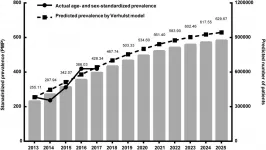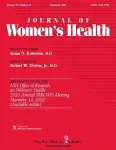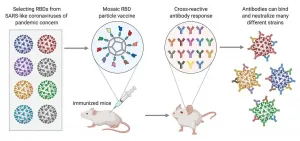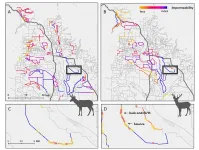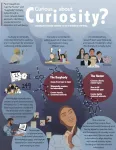Researchers speed up analysis of Arctic ice and snow data through AI
Large swaths of data collected through radar in the Arctic and Antarctic are often a challenge to process and understand. This AI technique enables researchers to notice data trends more quickly, improving their ability to make predictions
2021-01-12
(Press-News.org) Researchers at the University of Maryland, Baltimore County (UMBC) have developed a technique to more quickly analyze extensive data from Arctic ice sheets in order to gain insight and useful knowledge on patterns and trends. Over the years, vast amounts of data have been collected about the Arctic and Antarctic ice. These data are essential for scientists and policymakers seeking to understand climate change and the current trend of melting. Masoud Yari, research assistant professor, and Maryam Rahnemoonfar, associate professor of information systems, have utilized new AI technology to develop a fully automatic technique to analyze ice data, published in the Journal of Glaciology. This is part of the National Science Foundation's ongoing BigData project.
For decades, researchers have kept close track of polar ice, snow, and soil measurements, but processing the large volume of available data has proven challenging. NASA's processes for collecting, tracking, and labeling polar data involve significant manual work, and changes detected in the data can take months or even years to see. Even Arctic data collected via remote sensing technologies require manual processing.
According to Rahnemoonfar, "Radar big data is very difficult to mine and understand just by using manual techniques." The AI techniques she and Yari are developing can be used to mine the data more quickly, to get useful information on trends related to the thickness of the ice sheets and the level of snow accumulation in a certain location.
The researchers developed an algorithm that learns how to identify objects and patterns within the Arctic and Antarctic data. An AI algorithm must be exposed to hundreds of thousands of examples in order to learn how to identify important elements and patterns. Rahnemoonfar and her team used existing incomplete and noisy labeled data from the Arctic to train the AI algorithm on how to categorize and understand new data.
The algorithm's training is not yet complete, as it will need to be scaled up over multiple sensors and locations to create a more accurate tool. However, it has already successfully begun to automate a process that was previously inefficient and labor-intensive.
The rapid expansion of using AI technology to understand ice and snow thickness in the Arctic will allow scientists and researchers to make faster and more accurate predictions to inform international dialogue about climate change. The rate at which Arctic ice is melting impacts sea level rise, and if scientists are better able to predict the severity of the melting, society can better mitigate the harm caused by sea level rise.
INFORMATION:
ELSE PRESS RELEASES FROM THIS DATE:
2021-01-12
Study published in the American Journal of Kidney Diseases (AJKD) projects that prevalence of patients receiving dialysis in China will increase from 384.4 patients per million (PPM) in 2017 to 629.7 PMP in 2025 with a predicted 874,373 patients receiving dialysis in 2025.
The national prevalence of dialysis in China has not been well studied due to its large population and limited resources. Insurance claims data provide a unique opportunity to understand the burden of kidney failure and have been used to characterize dialysis patients in the ...
2021-01-12
Researchers at University of California San Diego School of Medicine, in collaboration with Dutch scientists, have found that certain metabolites -- small molecules produced by the process of metabolism -- may be predictive indicators for persons at risk for recurrent major depressive disorder.
The findings were published in the January 11, 2021 online issue of Translational Psychiatry.
"This is evidence for a mitochondrial nexus at the heart of depression," said senior author Robert K. Naviaux, MD, PhD, professor of medicine, pediatrics and pathology at UC San Diego School of Medicine. "It's a small study, but it is the first to show the potential of using metabolic ...
2021-01-12
New Rochelle, NY, January 12, 2021--The Centers for Disease Control and Prevention (CDC) is committed to removing unnecessary medical barriers to contraception use by people with certain characteristics or medical conditions. The CDC is celebrating the 10th anniversary of the release of its U.S. Medical Eligibility Criteria for Contraceptive Use (MEC), with an exclusive article published in the peer-reviewed Journal of Women's Health. Click here to read the article now.
The CDC has updated the MEC recommendations over the past decade based on new evidence. It has collaborated with national partners to disseminate and implement the guidelines and has conducted surveys of health ...
2021-01-12
The SARS-CoV-2 virus that is causing the COVID-19 pandemic is just one of many different viruses in the coronavirus family. Many of these are circulating in populations of animals like bats and have the potential to "jump" into the human population, just as SARS-CoV-2 did. Researchers in the laboratory of Pamela Björkman, the David Baltimore Professor of Biology and Bioengineering, are working on developing vaccines for a wide range of related coronaviruses, with the aim of preventing future pandemics.
Now, led by graduate student Alex Cohen, a Caltech ...
2021-01-12
Berkeley -- Each year, thousands of migratory mule deer and pronghorn antelope journey northwest from their winter homes in the Green River Basin, a grassland valley in western Wyoming, to their summer homes in the mountainous landscape near Grand Teton National Park.
But to reach their destination, these ungulates must successfully navigate the more than 6,000 kilometers (3,728 miles) of fencing that crisscrosses the region. That's enough distance to span nearly twice the length of the U.S.-Mexico border.
In a new study, wildlife biologists at the University of California, Berkeley, combined GPS location data of tagged mule deer and pronghorn with satellite imagery of ...
2021-01-12
Curiosity has been found to play a role in our learning and emotional well-being, but due to the open-ended nature of how curiosity is actually practiced, measuring it is challenging. Psychological studies have attempted to gauge participants' curiosity through their engagement in specific activities, such as asking questions, playing trivia games, and gossiping. However, such methods focus on quantifying a person's curiosity rather than understanding the different ways it can be expressed.
Efforts to better understand what curiosity actually looks like for different people have underappreciated roots in the field of philosophy. Varying styles have been described with loose ...
2021-01-12
A lurking threat that has stymied US corn growers for decades is now returning to the forefront: western corn rootworm. Sometimes referred to as the "billion-dollar bug," the species' tiny larvae chew through the roots of corn plants, causing devastating yield losses. In 2003, farmers began planting a genetically engineered variety of corn known as "Bt," which produces a protein toxic to the pest species - but by 2009, the billion-dollar bug had already evolved adaptations for resistance to the toxin.
A new study suggests that slowing the resurgence of western corn rootworm may require a larger-scale strategy than previously thought. The findings, ...
2021-01-12
BOSTON - While investigating the underlying causes of a rare skin disorder, a researcher at Massachusetts General Hospital (MGH) discovered a previously unknown mechanism in the kidneys that is important for regulating levels of magnesium and calcium in the blood.
The discovery, described in the journal Cell Reports, highlights the role of a previously little-studied gene called KCTD1. The gene directs production of a protein that regulates the kidney's ability to reabsorb magnesium and calcium from urine and return it to the bloodstream.
A genetic mutation causing the loss of KCTD1 results in defects in nephrons, ...
2021-01-12
You've heard of Old Faithful, the Yellowstone National Park geyser that erupts every hour or two, a geological phenomenon on a nearly predictable schedule.
Now, an international group of scientists who study space have discovered an astronomical "Old Faithful" - an eruption of light flashing about once every 114 days on a nearly predictable schedule. The researchers believe it is a tidal disruption event, a phenomenon that happens when a star gets so close to a black hole that the black hole "rips" away pieces of the star, causing the flare.
The team made the discovery using data from NASA and from a network of telescopes operated by The Ohio State University.
Their findings, presented today at the Astronomical Society's annual meeting and accepted for publication ...
2021-01-12
Researchers have found a simple way to eliminate almost all sequencing errors produced by a widely used portable DNA sequencer, potentially enabling scientists working outside the lab to study and track microorganisms like the SARS-CoV-2 virus more efficiently.
Using special molecular tags, the team was able to reduce the five-to-15 per cent error rate of Oxford Nanopore Technologies' MinION device to less than 0.005 per cent -- even when sequencing many long stretches of DNA at a time.
"The MinION has revolutionized the field of genomics by freeing DNA sequencing from the confines of large laboratories," says Ryan Ziels, an ...
LAST 30 PRESS RELEASES:
[Press-News.org] Researchers speed up analysis of Arctic ice and snow data through AI
Large swaths of data collected through radar in the Arctic and Antarctic are often a challenge to process and understand. This AI technique enables researchers to notice data trends more quickly, improving their ability to make predictions
